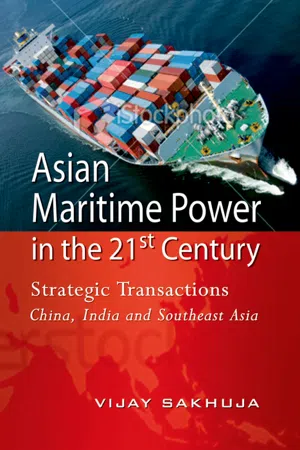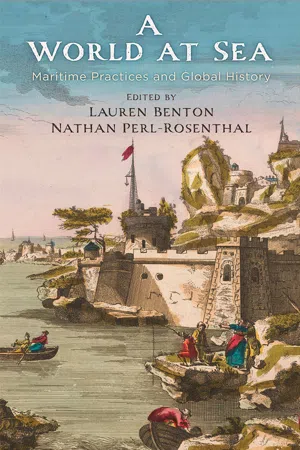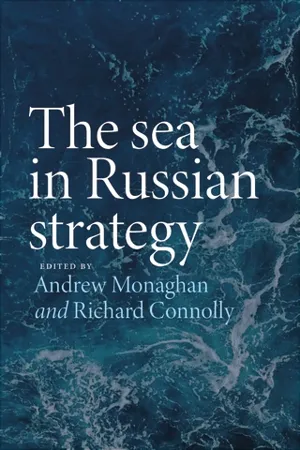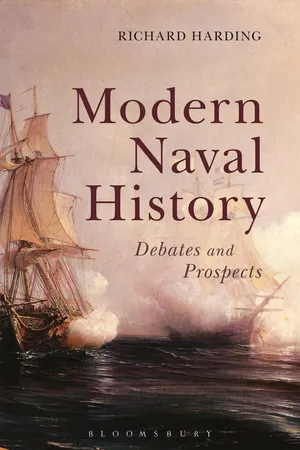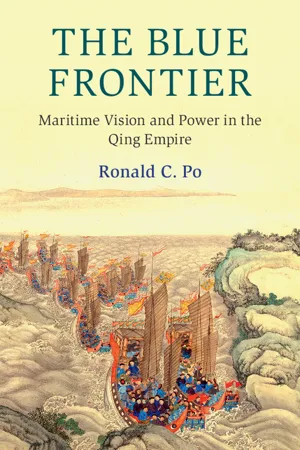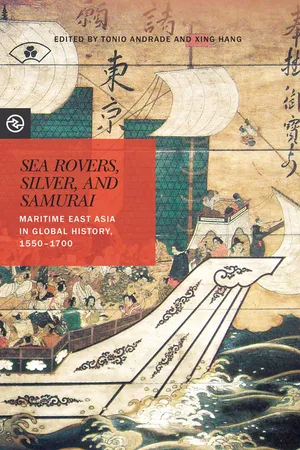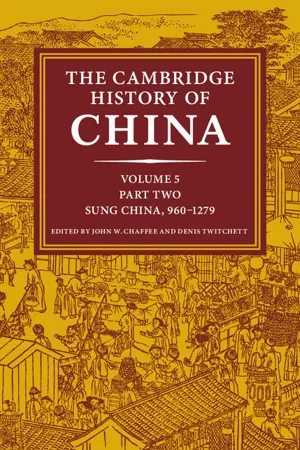History
Maritime Empires
Maritime empires were powerful states that expanded and maintained control over vast territories through sea-based trade, exploration, and naval dominance. These empires, such as the British, Portuguese, and Spanish, established colonies, controlled key trade routes, and exerted influence over distant lands, shaping global trade and politics for centuries.
Written by Perlego with AI-assistance
Related key terms
1 of 5
7 Key excerpts on "Maritime Empires"
- eBook - PDF
Asian Maritime Power in the 21st Century
Strategic Transactions China, India and Southeast Asia
- Vijay Sakhuja(Author)
- 2011(Publication Date)
- ISEAS Publishing(Publisher)
In the 21st century, maritime power continues to be the defining paradigm with the emergence of the economic order of globalization. The current economic growth trends among several Asian countries have provided an impetus and enormous lateral capacity for industrialization and military-strategic expansion manifest in their naval order of battle. From the above it is evident that the tendency of maritime powers in history has always been the augmentation of economic power through high rates of economic growth that has come with extensive trade. Significantly, maritime power emerges as the primary facilitator of the mercantile-based trading system of global capitalism and the military corollary emerges with the build-up of the navy of the state. Also, maritime powers have an aggregation of economic-industrial power that is sustained by a strong penchant for science and technology. CONCEPT OF MARITIME POWER The term maritime power implies various meanings and interpretations. Strategists, practitioners and analysts of maritime power have re-examined its constituents, importance and utility. Some prefer to use “sea power” while others have a preference for “maritime power”. 17 In its narrower scope, sea power is understood as “navy” for distant interventions and is synonymous with warships, submarines, aircraft carriers and navies. 18 At the other end of the spectrum, it is broadly understood as the ability of a state to use the sea to its optimum. It has also been argued that a great sea power may not be a maritime power although one follows from the other. 19 In that context, sea power is defined as a state that has formidable naval capabilities (ships, submarines, shipping in support of the military for specific missions) and maritime power is defined as the state that makes widespread access to the seas to sea resources for economic purposes that in turn provide the state with a significant position in its power relations. - eBook - ePub
A World at Sea
Maritime Practices and Global History
- Lauren Benton, Nathan Perl-Rosenthal, Lauren Benton, Nathan Perl-Rosenthal(Authors)
- 2020(Publication Date)
- University of Pennsylvania Press(Publisher)
6In the postwar decades, a more specialized scholarship on maritime commerce began to appear. Some, like influential studies by Bernard Bailyn and Richard Pares, connected commerce to imperial and interimperial currents of colonization and warfare, while other works explored oceanic patterns of trade, such as Huguette and Pierre Chaunu’s Séville et l’Atlantique and, later still, K. N. Chaudhuri’s pathbreaking Trade and Civilisation in the Indian Ocean. Unlike naval histories, studies of commerce rarely probed the lives of seafarers, in part reflecting the limitations of merchants’ records in this regard. Yet many of these works were highly attuned to questions of law and jurisdiction: Pares and the Chaunus, for instance, highlighted tensions over illicit interimperial trade, and Chaudhuri insisted that Indian Ocean seaborne trade formed part of a broader phenomenon of Asian commercial capitalism.7These two oldest strands within maritime historiography had the virtue—from the vantage point of contemporary scholarship—of being oceanic in scope, and even precociously global. Naval history, though firmly inserted within national historiographies in one sense, was in another sense resolutely border crossing. Naval historians followed vessels, officers, and enlisted men wherever they traveled, revealing connections not just within but also across oceans. Many naval historians, too, regarded their subject with a comparative eye: an empire or nation’s sea power could only be understood, after all, in relation to other naval forces. Many historians of maritime commerce were also decidedly global in their orientation. Some of the earliest works closely examined the high-value, long-distance operations of European trading companies, such as the Dutch East and West India Companies, the French Levant Company, and the British East India Company.8 - eBook - ePub
- Andrew Monaghan, Richard Connolly, Andrew Monaghan, Richard Connolly(Authors)
- 2023(Publication Date)
- Manchester University Press(Publisher)
Part IMaritime strategies in historical contextPassage contains an image
1Russia and some principles of maritime strategy
Andrew LambertMaritime states and sea power
If we are to interpret Russia’s strategy at sea, we must begin by disentangling two concepts that are generally conflated or misused. The first is that of a “seapower”, the Greek word thalassokratia that Herodotus and Thucydides used to describe states dominated by the sea, where the ocean was central to their prosperity and power, ultimately a question of identity and culture.1 Being a cultural seapower did not require a state to possess a powerful navy, although they often did, but that they prioritised the navy over other forms of defence. While the first seapower was Periclean Athens, it was not the greatest naval power of the age. That status belonged to the Persian Empire.2 A vast multinational empire stretching from western Greece to Egypt, Arabia, and the borders of India, Persia harnessed the naval and maritime skills of subject peoples to move armies and support campaigns of conquest. Its capital was a long way from the sea, an element that Persian rulers found alien and alarming. A continental imperial power with a powerful fleet, Persia was the precursor of Rome and Byzantium – and modern Russia.These hegemonic empires used sea power, a phrase coined by Captain Alfred Thayer Mahan in his book The Influence of Sea Power upon History, 1660–1783, which examined the strategic use of the sea for political ends, broadly defined.3 Mahan split the Greek word thalassokratia into a new phrase, because he could not use the examples of Athens, Venice, or Britain as precursors for his strategic argument that the United States needed a large navy. Those states were too small, weak, and above all maritime to inform the identity of an emerging continental superpower.Instead, he emphasised the strategic use of the sea by Republican Rome, a continental military empire bent on hemispheric dominion. His classical model was not the rise of a Carthaginian seapower state, but its annihilation by Roman military power. Similarly, his modern example was not the rise of Britain, but the failure of continental France to achieve the naval hegemony it needed to crush feeble seapower opponents and become a new Roman Empire. Mahan wanted his countrymen to understand that the root causes of French failure lay in poor strategic choices, not a continental identity. He recognised that his country would inherit the Roman mantle, not the British. - eBook - PDF
Modern Naval History
Debates and Prospects
- Richard Harding(Author)
- 2015(Publication Date)
- Bloomsbury Academic(Publisher)
3 As will be shown, naval history, on the coat-tails of this phenomenon, is following a similar path. Thus, navies and naval power, while seldom explicitly explored in detail, are still deeply embedded in the history curriculum. Maritime Empires, confessional politics and navies, 1500–1650 The need to control violence on the sea has been a perennial concern of societies ever since mankind took to the water for migration or trade. From antiquity, robbery at sea and raiding were common ways of making a living, but the cost and complexity of sustaining a major presence at sea could only be borne by relatively few sophisticated societies. Societies around the China Sea were capable of projecting formidable naval power from the thirteenth century AD, which made those waters a vital contested space for centuries. For a short period between 1417 and 1423, the Ming Empire dominated the waters as far as the western edge of the Indian Ocean. 4 In Europe, cities such as Venice and Genoa or confederations like the North German Hansa League were important actors in their regional maritime environments. 5 By the 1520s, three new factors were at play in Europe. First, the discovery, between the 1470s and the 1490s, of the oceanic trade routes to the Far East and to America had unleashed massive expectations regarding the economic potential of global trade. Second, the Reformation from 1517 had begun to split Europe into hostile camps based on deep convictions far exceeding the usual dynastic rivalries that had divided Europeans for centuries. Third were the changes in warfare being experienced as a result NAVIES, POLITICS AND GOVERNMENT, 1500–1789 67 of technological, economic and political changes. Historians have focused on these three dimensions of European society in their quest to understand the development of the early modern world, and continue to contest their relative significance. - eBook - PDF
The Blue Frontier
Maritime Vision and Power in the Qing Empire
- Ronald C. Po(Author)
- 2018(Publication Date)
- Cambridge University Press(Publisher)
For details, see Gang 4 Introduction seventeenth century, the empire had been integrated into the maritime world through its maritime militarization and seaborne shipping. Even if the Qing was commonly seen as a continental empire, at least by the end of the eighteenth century, it does not follow that it was incapable of exerting its influence across the sea. I believe this refusal to acknowledge the Qing or China as a maritime power is largely conditioned by an ingrained notion that an early modern empire can either be a land power or a maritime power but cannot be both, and that its focus is primarily influenced by social and cultural factors, such as traditions, religions, and beliefs. This book will present a more balanced picture of the geopolitics of the Great Qing, which has long been obscured by the reductive logic that divides land and sea. It has been suggested that “empire building was dependent upon the ability to mobilize irresistible armies and navies.” 6 I aim to counter the conventional wisdom as I argue that Qing land and sea policies were closely linked. Indeed, I will prove that the state’s engagement with the sea, in terms of its political vision, its military deployment, and its administrative practice, was proactive and substan- tial throughout most of the long eighteenth century, which spanned from around 1680 to the decade after the death of the Qianlong emperor in 1799. 7 In other words, I suggest we avoid the kind of reasoning that a coun- try’s political and military policies are based on certain identifying factors of its civilization or culture, thereby pointing to it being either land-based or sea-based and not both. Georg Hegel (1770–1831) and Max Weber (1864–1920), the creator and the chief proponent of ideological deter- minism, respectively, believed that social development is predominantly fostered by a spirit or an ideology. - eBook - PDF
Sea Rovers, Silver, and Samurai
Maritime East Asia in Global History, 1550–1700
- Tonio Andrade, Xing Hang, Anand A. Yang, Kieko Matteson(Authors)
- 2016(Publication Date)
- University of Hawaii Press(Publisher)
1 I NTRODUCTION The East Asian Maritime Realm in Global History, 1500–1700 Tonio Andrade and Xing Hang M aritime East Asia is a contentious place. Traversed by some of the world’s busiest shipping lanes and endowed with rich fisheries and huge deposits of oil, it is a confusing morass of contested sovereignties and geopolitical rivalries. Few maritime regions today are subject to such dissonant and dangerous claims and counterclaims, with Filipino, Japanese, Chinese, Taiwanese, Vietnamese, Malaysian, and Bru-neian pirates, statesmen, soldiers, and civilians disputing isolated—and of-ten uninhabited—atolls. An East Asian war is more likely to erupt over the Diaoyu or Spratly Islands than over any land borders. This unsettled situation is a legacy of the peculiar history of East Asia’s maritime realm. Stretching from the Strait of Malacca to the Sea of Japan and centered upon the East and South China Seas, the seaways of East Asia have been a core region of international trade for centuries. However, dur-ing the period from 1500 to 1700, the velocity and scale of that commerce increased dramatically. The lucrative export of massive quantities of silver from Japan for Chinese silk and Southeast Asian tropical goods wove the region together into a coherent zone of exchange. Besides the Chinese junks, the Japanese red-seal ( shuin ) vessels, and the Southeast Asian jongs that be-came a staple of its ports and sea lanes, Indian dhows, Spanish galleons, and Dutch and English men-of-war increasingly connected maritime East Asia to a thriving global economic system that also comprised the Indian Ocean, Europe, and the Americas. Maritime East Asia shares much in common with other maritime “worlds”—the Mediterranean World, the Atlantic World, and the Indian Ocean World. These zones of trade and communication have received far more scholarly attention, and in fact, historians of East Asia have tried to understand East Asian waterways in terms of those other oceans. - John W. Chaffee, Denis Twitchett(Authors)
- 2015(Publication Date)
- Cambridge University Press(Publisher)
CHAPTER 7 CHINA’S EMERGENCE AS A MARITIME POWER Angela Schottenhammer introduction Studies of “international,” supra-regional trade relations in ancient and middle-period China often give the impression that the Chinese were not really interested in foreign trade as a commercial undertaking and that all they would tolerate was a form of official tribute trade (ch’ao-kung mao-i). This picture is misleading. Upon closer examination it becomes evident that much more trade went on than official documents reveal. In the course of the T’ang (618–907), the Five Dynasties (907–60), and the Sung (960–1279), a steady increase in maritime trade resulted in the official policy and attitude towards trade becoming more and more positive and open. By late Sung times, China was a maritime power and an emporium of commodity exchange in the medieval Asian world. 1 Trade relations between China and peoples west of the Himalayas are well known because of the famous overland route, the Silk Road. As archaeological evidence reveals, commodity exchange along this route can be traced back at least to the sixth or seventh century bc. 2 Maritime trade con- tacts between China and countries overseas, on the other hand, emerged later, but can still be traced back at least to the Han dynasty (220 bc–ad 220). 3 The numerous middlemen along the overland trading routes who took a large share of the profits probably stimulated some merchants to travel by sea after about 1 An excellent account of China’s rise as a sea power is Lo Jung-pang’s posthumously published manuscript edited, and with commentary, by Bruce A. Elleman. Lo Jung-pang, China as a sea power 1127–1368: A preliminary survey of the maritime expansion and naval exploits of the Chinese people during the Southern Song and Yuan periods, ed.
Index pages curate the most relevant extracts from our library of academic textbooks. They’ve been created using an in-house natural language model (NLM), each adding context and meaning to key research topics.
